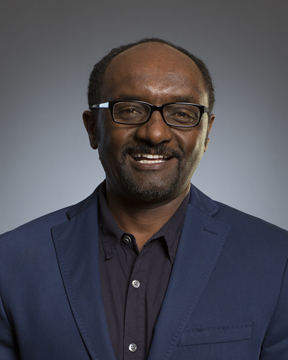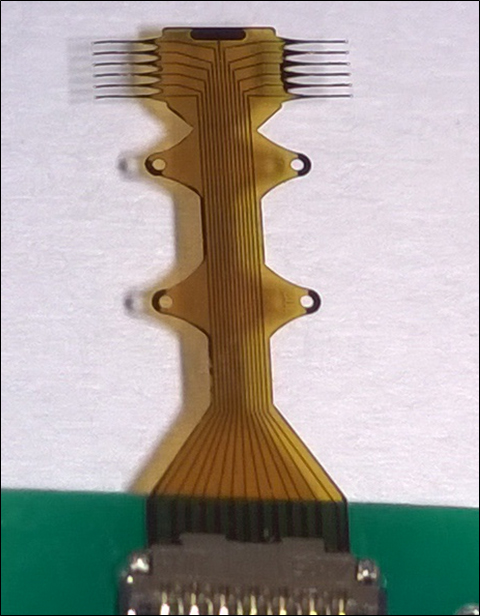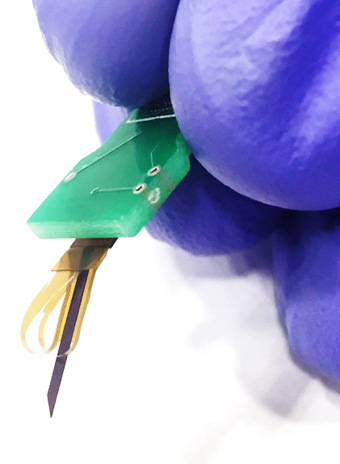 As part of his work with the Center for Sensorimotor Neural Engineering (CSNE), Dr. Sam Kassegne, one of the CSNE's Communication and Interface research leaders and CSNE deputy director at San Diego State University (SDSU), along with his SDSU colleagues and students, is developing a special kind of electrode to be used in brain-computer interfaces. This "glassy carbon" electrode both electrically stimulates (sends information) and records (receives information) from neurons in the brain.
As part of his work with the Center for Sensorimotor Neural Engineering (CSNE), Dr. Sam Kassegne, one of the CSNE's Communication and Interface research leaders and CSNE deputy director at San Diego State University (SDSU), along with his SDSU colleagues and students, is developing a special kind of electrode to be used in brain-computer interfaces. This "glassy carbon" electrode both electrically stimulates (sends information) and records (receives information) from neurons in the brain.
A new journal publication released this month in Nature Science Reports, “Highly Stable Glassy Carbon Interfaces for Long-Term Neural Stimulation and Low-Noise Recording of Brain Activity” features the recent progress in this research.
"This paper has helped establish the technology as superior to existing research-grade and commercial thin-film probes that are used to sense and stimulate the surface of the brain, with regard to much lower corrosion rate (especially under electrical stimulation) that [allows brain-computer interfaces to remain implanted] over a period of years," Kassegne said. "The paper showed that existing probes based on thin-film metals lasted much fewer number of cycles under clinically-relevant levels of stimulation before corroding and failing."
 Traditional electrode implants are metal-based, usually made of gold, platinum or titanium to help ensure good conductivity and inertness. Kassegne’s development of glassy carbon electrodes is promising to be a significant step forward. Glassy carbon electrodes can record and transmit clearer, more robust electrical signals, and they are also superior in that they resist corrosion and demonstrate greater biocompatibility, resulting in less scar tissue within the brain.
Traditional electrode implants are metal-based, usually made of gold, platinum or titanium to help ensure good conductivity and inertness. Kassegne’s development of glassy carbon electrodes is promising to be a significant step forward. Glassy carbon electrodes can record and transmit clearer, more robust electrical signals, and they are also superior in that they resist corrosion and demonstrate greater biocompatibility, resulting in less scar tissue within the brain.
Kassegne's NeuroMEMS lab is the first in the world to introduce the neural application of micro-fabricated glassy carbon electrodes for brain-computer interfaces, and he and his colleagues at SDSU have already widely published in this area with data that supports the use of glassy carbon electrodes in animal models. The CSNE and Kassegne’s team are leading the field in this area of research with carbon material.
 Graduate students at SDSU are an integral part of this research and the contribution Kassegne's lab is making. Maria Vomero (currently working on her PhD), Pieter van Niekerk and Mieko Hirabayashi (PhD candidate) are some of the key CSNE-affiliated graduate students. Dr. Chet Moritz’s and Dr. Steve Perlmutter’s labs at the University of Washington and Luciano Fadiga’s Lab in IIT at Ferrara, Italy (and IIT's graduate students) are key strategic collaborators.
Graduate students at SDSU are an integral part of this research and the contribution Kassegne's lab is making. Maria Vomero (currently working on her PhD), Pieter van Niekerk and Mieko Hirabayashi (PhD candidate) are some of the key CSNE-affiliated graduate students. Dr. Chet Moritz’s and Dr. Steve Perlmutter’s labs at the University of Washington and Luciano Fadiga’s Lab in IIT at Ferrara, Italy (and IIT's graduate students) are key strategic collaborators.
Glassy carbon electrodes are also unique in that these electrodes have capacity not only to deliver and receive higher-quality electrical signals, but they can also simultaneously detect in real-time electrochemical signals (neurotransmitters, like serotonin and dopamine) released by neurons as they communicate with the electrode. It is theorized that neurotransmitters modulate the electrical information passed back and forth between neurons, and thus the corresponding behaviors dictated by neurons (such as moving your arm or leg).
 The tangible human impact of this work is that when glassy carbon electrodes are successfully integrated into brain-computer interfaces developed by the CSNE, they will enable the interface to send and receive a richer set of sensorimotor data and last much longer within the body. This means, for example, that a brain-computer interface incorporating glassy carbon electrodes and designed to reanimate a paralyzed limb would allow the user much finer movement control, and fewer surgeries would be required to replace corroded electrodes over the life of the implant.
The tangible human impact of this work is that when glassy carbon electrodes are successfully integrated into brain-computer interfaces developed by the CSNE, they will enable the interface to send and receive a richer set of sensorimotor data and last much longer within the body. This means, for example, that a brain-computer interface incorporating glassy carbon electrodes and designed to reanimate a paralyzed limb would allow the user much finer movement control, and fewer surgeries would be required to replace corroded electrodes over the life of the implant.
"With the technology now demonstrated to have key advantages over existing commercial and research-grade thin-film technologies (coupled electrical and electrochemical detection, higher signal to noise ratio, very low corrosion rate), the next logical step is human trials," Kassegne said. "We are currently working closely together with our collaborators to go to the next level."
For more information about Dr. Kassegne and his CSNE-affiliated team's work at SDSU, please visit the NeuroMEMS lab website or contact Dr. Kassegne.
